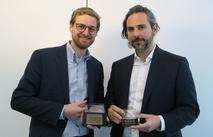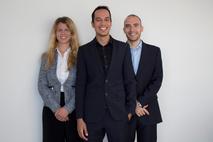Microchip and 3D models given a financial kick
07.05.2018
LIGENTEC and Mirrakoi have each received CHF 130,000 after winning stage 3 of Venture Kick. LIGENTEC designs photonic integrated circuits (PICs) for the digital revolution, whereas Mirrakoi brings Computer Aided Design (CAD) of 3D models to all new level of simplicity.
 LIGENTEC
|
 Mirrakoi
|
LIGENTEC (EPFL) Photonic microchip enabling new technologies
Within the connected reality in the modern world there has been an explosion of data, use of sensors and connected devices. LIGENTEC offers an innovative technology to cope with the power consumption and size of new connected systems using photonic integrated circuits (PIC). The PIC is a microchip where photons (light) are manipulated to carry the data by using new manufacturing techniques. The startup has created a novel method to manufacture these chips using silicon nitride in order to improve efficiency. By making the chips out of material thicker than normal industry standards, this allows them to have a much lower bending radius, enabling a denser circuit design on a chip. In fact, the new manufacturing methods have allowed the chip to transmit with three times lower loss and an area 10 times smaller than current industry solutions and can integrate more than 200 fiber or bulk optics components on a fingertip sized chip.
But this new technology isn’t limited to just the telecommunications market, the team envisage spreading to LIDAR and bio-sensing. Co-founder Michael Geiselmann says “This technology will revolutionize the PIC market” adding that his Venture Kick experience “was an excellent business preparation to face the real world of business growth and investors.”
Mirrakoi (EPFL) 50x faster design software for manufacturing, product design and architecture industry
In the age of industry 4.0, architects, engineers, and manufacturers all over the world increasingly depend on digital design and simulation software. Computer-aided design (CAD) is at the heart of any digital modeling task, however, it is expensive, difficult to use and requires lots of training expertise in order to produce production-ready digital models. Mirrakoi has invented a brand-new technology called ‘augmented CAD’, which allows engineers and product designers to create digital models with higher precision and efficiency, less expertise, and faster than today’s technology, especially adapted for complex and non-planar shapes. Augmented CAD is based on a novel way to represent digital geometry by simulating physical continuity between two objects in revolutionary way. Mirrakoi’s first product is called ‘Xirus’ and is fully compatible with some of the most widely used CAD software in industry.
Through offering augmented CAD, the startup will reduce the time spent on creating 3D models and overcomes current challenges in the manufacturing and architecture industry. Speaking about his inspiration for the startup, co-founder Daniel Schmitter says “We first started working on digital shape representation in clinical and biological research such as digital brain and cell modeling. Afterwards, we noticed that our research results also solved problems related to digital geometry in computer graphics and animation, which led us to study the CAD-industry and its current challenges. This is when we began to realize that we might have also found a solution to a market problem and not only a research problem."
Within the connected reality in the modern world there has been an explosion of data, use of sensors and connected devices. LIGENTEC offers an innovative technology to cope with the power consumption and size of new connected systems using photonic integrated circuits (PIC). The PIC is a microchip where photons (light) are manipulated to carry the data by using new manufacturing techniques. The startup has created a novel method to manufacture these chips using silicon nitride in order to improve efficiency. By making the chips out of material thicker than normal industry standards, this allows them to have a much lower bending radius, enabling a denser circuit design on a chip. In fact, the new manufacturing methods have allowed the chip to transmit with three times lower loss and an area 10 times smaller than current industry solutions and can integrate more than 200 fiber or bulk optics components on a fingertip sized chip.
But this new technology isn’t limited to just the telecommunications market, the team envisage spreading to LIDAR and bio-sensing. Co-founder Michael Geiselmann says “This technology will revolutionize the PIC market” adding that his Venture Kick experience “was an excellent business preparation to face the real world of business growth and investors.”
Mirrakoi (EPFL) 50x faster design software for manufacturing, product design and architecture industry
In the age of industry 4.0, architects, engineers, and manufacturers all over the world increasingly depend on digital design and simulation software. Computer-aided design (CAD) is at the heart of any digital modeling task, however, it is expensive, difficult to use and requires lots of training expertise in order to produce production-ready digital models. Mirrakoi has invented a brand-new technology called ‘augmented CAD’, which allows engineers and product designers to create digital models with higher precision and efficiency, less expertise, and faster than today’s technology, especially adapted for complex and non-planar shapes. Augmented CAD is based on a novel way to represent digital geometry by simulating physical continuity between two objects in revolutionary way. Mirrakoi’s first product is called ‘Xirus’ and is fully compatible with some of the most widely used CAD software in industry.
Through offering augmented CAD, the startup will reduce the time spent on creating 3D models and overcomes current challenges in the manufacturing and architecture industry. Speaking about his inspiration for the startup, co-founder Daniel Schmitter says “We first started working on digital shape representation in clinical and biological research such as digital brain and cell modeling. Afterwards, we noticed that our research results also solved problems related to digital geometry in computer graphics and animation, which led us to study the CAD-industry and its current challenges. This is when we began to realize that we might have also found a solution to a market problem and not only a research problem."


